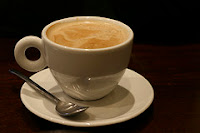Executive Summary about Decaf Coffee by Kurt A. Schefken
 Decaf Coffee. Nowadays, people are becoming aware of the advantages of good health. People are becoming choosy with what they eat. One of the things that people are avoiding is coffee, which is known to be rich in stimulants.
Decaf Coffee. Nowadays, people are becoming aware of the advantages of good health. People are becoming choosy with what they eat. One of the things that people are avoiding is coffee, which is known to be rich in stimulants.
Lately a specimen of the coffee tree has been found that has almost nil caffeine naturally. Till the time that variety lands up into commercial usage, we have to content ourselves with the current practices of discarding the unwanted caffeine from coffee. One of the processes of removal caffeine from coffee is treating it boiled water and then washing in methylene chloride.
So what if the water of the swimming pool is really hydrochloric acid and not methylene chloride. Chemically removing caffeine from unroasted, green grounds begins by heating them in steam or hot water. Now the beans are washed in methylene chloride, which sticks to the caffeine and is then rinsed away.
Another method is to soak the beans in hot water for a few hours. Through this the caffeine is leached out into the liquid. The beans are removed and methylene chloride is put into the water. Now it binds itself to the caffeine and not the flavored elements that have flushed out of the bean. The beans are put into the bath again where they again absorb the flavor components.
Lets consider the taste. One of the issues that people have reported with decaf is the difference in its taste when compared to the regular dark roast coffee. The typical taste of coffee results from the presence of caffeine. Since the caffeine is removed from the beans, resulting in coffee that is devoid of the typical taste. For people who want to switch to decaf on a regular basis, it is advisable that they make the switch slowly.












No comments:
Post a Comment